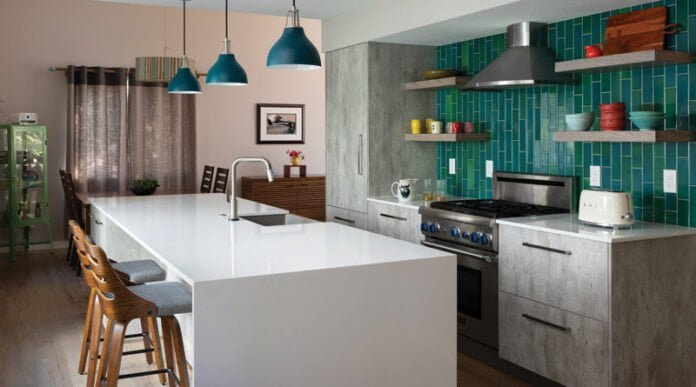The kitchen and bath industry will more than make up for the losses of 2020, according to research from the National Kitchen & Bath Association. After slower growth prior to the pandemic, NKBA projects the industry will grow by 16.6% in 2021, compared to a nearly 6% decline last year.
“Most of the projected 2021 growth for kitchen and bath is a delayed response to pent-up demand from 2020, but there are also new factors largely resulting from the pandemic that play into the expected strong growth,” according to an NKBA spokesperson.
Among those is the ongoing influence of do-it-yourself home improvement projects. Although NKBA anticipates homeowners will increase spending on professional remodels this year, some homeowners will continue to undertake projects on their own.
The economic hit of last year is a significant factor in their decision making. Consumer spending on goods and services in the United States fell 11% in 2020, compared to a 2% decline during the Great Recession. Meanwhile, the Center on Budget and Policy Priorities reported in April that 27% of Coloradans were struggling to cover their usual household expenses. It’s no surprise, then, that a quarter of homeowners want to do their own renovations as a way to save money, according to NKBA data.
“The bottom line is that many homeowners spent much of 2020 involved in band-aid solution projects, but held off on full-scale remodels, which often involve professional designers,” an NKBA spokesperson said. Residential remodeling accounts for 43% of kitchen and bath spending, according to the association.
The association found that the kitchen is a site of particular interest for homeowners after spending more time at home, many of them cooking more than they had in prior years. Seventy percent of homeowners called the kitchen “extremely important,” compared to 64% prior to the pandemic, according to NKBA’s research. Although typically, kitchen remodels are the most likely projects to involve a professional, the pandemic made it unrealistic for most homeowners.
“Given that the kitchen was becoming more of a family hub during the pandemic, as more and more people were working from home and their kids involved in remote schooling, having a professional coming in to tear the room apart at that time was unfeasible,” the spokesperson said. That’s expected to change, as now “they have already done the easy DIY projects, and know they need professional involvement for the more serious redesigns that they can no longer put off.”
Building boom
However, the biggest driver of kitchen and bath spending is coming from builders, NKBA found. The association found 57% of the total kitchen and bath spending is happening on new construction projects. Single-family starts increased 10% in 2020, NKBA found.
The National Association of Home Builders found a sharp increase in homebuyer interest in new construction. The Housing Trends Report shows that in the first quarter of 2021, 42% of homebuyers were looking at new construction, compared to 30% who were shopping for existing homes. In the first quarter of 2020, homebuyers were almost twice as likely to consider an existing home over a new home: 40% compared to 24%.
In the West Census region, which includes Colorado, 53% of homebuyers were considering a new home in the next 12 months, compared to 23% who were shopping for existing homes.
Design, functionality drive kitchen design
Whether they go it alone or hire a professional, NKBA found that homeowners who undertake a remodel are primarily interested in updating the design of their kitchens and bathrooms, citing aesthetics as their main motivation. However, improving functionality was also a driver. Over half of budget projects involved upgrading cabinets, while 43% focused on plumbing. Higher end projects included installing smart home products (57%) or water filtration systems (54%).
Colorado is a unique market for design, according to Austin Ardrey, general manager at Christopher’s Kitchens & Baths in Denver and Englewood.
“We have super traditional and super contemporary” styles, he noted. “Not only do we have a lot of transplants, but markets are so different even neighborhood to neighborhood.” There are some tenacious trends that haven’t fully shaken out, though.
White-on-white kitchens are still a common choice for homeowners. They’re a conservative choice with a timeless look, Ardrey noted.
Related: Storage, functionality highlight 2021 kitchen design trends
“I think we can all thank Pinterest for that; everybody wanted a white shaker kitchen for three straight years,” he said. Some homeowners are starting to experiment with colors that speak more to their personality, especially if they plan on staying in their homes and aren’t worried about resale.
“We’ve done some really cool vintage colors, like seafoam greens, and kind of fun, unique stuff like that recently,” Ardrey said. “When people want to stay in the house, they’re a lot more willing to do what they really love.”
Thrive Home Builders’ ethos of constructing efficient, healthy homes means that all of its kitchen and bath options have to help meet those standards.
“We’re kind of unique in what we do,” Jennifer Ganstine, interior design coordinator for Thrive, said. “All the products that we do put in our homes have to meet indoor air quality” standards, she said. Carpet, adhesive, paint and anything else have to emit low VOCs to be considered.
Ganstine is responsible for developing design packages that buyers can select from. Thrive offers a baseline package plus three more premium options. Backsplashes are a key focal point that get a lot of her attention, she said.
“Grays and whites are really what dominates most of the packages, with a few that are kind of an off white; not truly an ivory but more of a khaki, just in case someone wants something a little bit warmer,” she said.
Modern designs with white-on-white elements and flat or dark gray cabinets are popular, particularly among Thrive’s target buyer. Even so, urban farmhouse is Thrive’s most popular design package. Ganstine noted it’s the first premium package above the baseline, so there may be an economic factor at play, but “it also is a package that is very on trend right now.”
Pandemic-friendly design
Some design elements have gotten buyers’ interest since the pandemic, but Thrive’s focus on healthy homes put touchless features on their radar early.
Prior to the pandemic, Gene Myers, CEO of Thrive and Bill Rectanus, vice president of homebuilding operations, approached her to incorporate some new features into the design packages, especially in the kitchen. “They kind of were like, ‘We think the next step is just doing some touchless stuff,’” Ganstine said.
The healthy home packages include touchless faucets in the kitchen, InSinkErator inline water filtration systems with hot and cold taps, and carbon filters.
“We have really high MERV filters, but this just gives you another element by putting carbon filters into our system with MERV filters,” she explained.
Bathrooms shine light on luxury
Thrive has held off on incorporating touchless features in bathrooms “because we offer a good array of options to buyers, and we’re starting to see touchless just coming into bathrooms,” she said. As products become more readily available and less expensive, they’ll begin incorporating them into designs more.
The higher-end healthy home package includes a self-cleaning toilet by Kohler, and a standalone bidet in the master bathroom.
Ardrey suggested that touchless faucets sometimes promise more than they can deliver. “Every single time we’ve sold one, we’ve ended up replacing it,” he said. “Either it’s the learning curve or they end up having faults.” Now his team tries to convince homeowners to use standard faucets, especially in rooms where they’re going to get a lot of use.
“If it’s in a powder bath and it’s a little automatic faucet that clicks on when you wash your hands, that’s totally different than a kitchen faucet where you’re trying to do dishes,” he said.
Today’s bathroom trends started to take shape years ago, he added.
“The stuff that’s super popular now, we started seeing a few years ago. It kind of gets into the mainstream, and it just takes time for people to kind of accept it and go with the trend.”
That includes freestanding tubs, zero-threshold showers and wet rooms, as well as solid surface products like Neolith, ARC and Fiora that allow for more open, luxurious areas. Electronic valves and smart shower systems have also become more reliable and available, he said. Like Ganstine, Ardrey has seen increased interest in bidets and washlets. He believes the increase in inexpensive options on the market has made homeowners more comfortable with options that are “very expensive from the manufacturers that do them right.”
Related: Homeowners bidet goodbye to boring bathrooms
Ardrey believes that some of the changes and upgrades that people have made in their homes to accommodate lifestyle changes brought on by the pandemic will be accepted long after the pandemic ends. They aren’t necessarily “trends,” he explained, but “a natural need that [was] easy to avoid” when people had more options to be outside their homes.
“People realize the importance of having a home that you like and that works for you ergonomically,” he said, “because … you spend an enormous amount of time in these spaces.”








